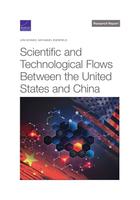Strategic competition between the United States and China colors how bilateral science and technology collaboration is interpreted in the United States. The objective of this report is to quantify and describe three types of scientific and technological flows between the United States and China to help assess the net effect of these types of flows on U.S. national security.
Download
Download eBook for Free
| Format | File Size | Notes |
|---|---|---|
| PDF file | 2.1 MB | Use Adobe Acrobat Reader version 10 or higher for the best experience. |
Purchase
Purchase Print Copy
| Format | List Price | Price | |
|---|---|---|---|
| Add to Cart | Paperback64 pages | $24.00 | $19.20 20% Web Discount |
Research Questions
- What are the potential benefits and risks of U.S.-Chinese scientific research collaboration?
- What is the nature and volume of scientific researcher flows between the United States and China?
- What potential threats and benefits have emerged from the recent uptick in scientific collaboration between the United States and China on aerospace engineering research?
Scientific and technological competition has emerged as a front on which strategic competition between the United States and China is contested. Scientific and technological dominance — the prize of this competition — has been recognized as a national priority by high-level leadership from both countries. This dominance can be attained in two primary ways: A country can rely on its domestic scientific and technology innovation resources and activities, or it can leverage foreign scientific and technological assets. The researchers focused on the second approach for this study; in this report, they describe the benefits and liabilities associated with U.S.-Chinese scientific research collaboration. Specifically, the researchers investigated three types of flows between the United States and China: the inflow of U.S. technology inputs into Chinese military technology, the bilateral movement of scientific researchers between the United States and China, and scientific collaboration between researchers based in the United States and those based in China.
Key Findings
U.S.-Chinese scientific research collaboration poses potential risks and offers potential benefits
- Publications produced via U.S.-Chinese collaboration have, on average, higher impact and are more interdisciplinary.
- Although a U.S. research collaboration with a Seven Sons university or a university affiliated with the People’s Liberation Army (PLA) does not, in itself, constitute a harm to national security, bilateral collaborations might present national security risks if knowledge and technology produced in the United States are used by China to modernize its military or otherwise gain competitive advantage.
- Sound policy will require assessment of the costs and benefits to openness.
Scientific research flows between the United States and China vary in nature and volume
- U.S.-based researchers tended to migrate to a Chinese affiliation rather than leaving and returning to the United States. Chinese-based researchers more often returned to China after a period in the United States.
- Most internationally mobile researchers obtained multi-affiliations at some point. Researchers who obtained a multi-affiliation more often returned to an affiliation in their home country or maintained their multi-affiliation rather than ultimately migrating.
U.S.-Chinese collaboration on aerospace engineering research poses potential threats and benefits
- In terms of threats, U.S.-based organizations have coauthored more aerospace engineering publications with Chinese organizations with links to the PLA in recent years than in the past.
- In terms of benefits, aerospace publications written by teams composed of researchers from the United States and China have greater-than-average influence and are more interdisciplinary.
- Among internationally mobile researchers, returnees had the greatest influence via number of citations.
Table of Contents
Chapter One
Introduction
Chapter Two
Identifying the Sources of Technological Inputs to Chinese Military Technology
Chapter Three
Assessing the Flow of Academic Researchers Between the United States and China
Chapter Four
Exploration of the Potential Risks and Benefits of China-U.S. Collaboration in Aerospace Research
Chapter Five
Conclusion
Research conducted by
This research was sponsored by the Office of the Secretary of Defense and conducted within the Acquisition and Technology Policy Program of the RAND National Security Research Division (NSRD).
This report is part of the RAND Corporation Research report series. RAND reports present research findings and objective analysis that address the challenges facing the public and private sectors. All RAND reports undergo rigorous peer review to ensure high standards for research quality and objectivity.
This document and trademark(s) contained herein are protected by law. This representation of RAND intellectual property is provided for noncommercial use only. Unauthorized posting of this publication online is prohibited; linking directly to this product page is encouraged. Permission is required from RAND to reproduce, or reuse in another form, any of its research documents for commercial purposes. For information on reprint and reuse permissions, please visit www.rand.org/pubs/permissions.
The RAND Corporation is a nonprofit institution that helps improve policy and decisionmaking through research and analysis. RAND's publications do not necessarily reflect the opinions of its research clients and sponsors.
